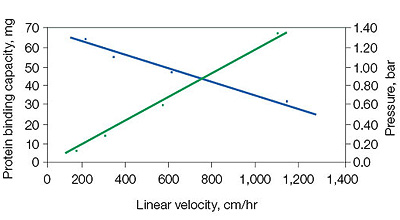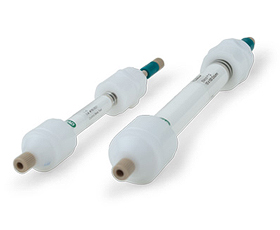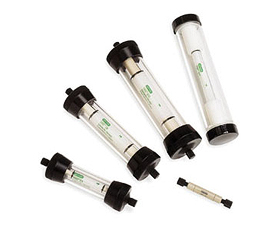Selecting a Cation Exchange Column
Bio-Rad has a wide selection of cation exchange columns covering a broad range of cation exchange chromatography applications. Column configurations have been optimized for all steps of purification and analysis, from capture through intermediate purification to contaminant removal and polishing. Select the best cation exchange column based on the following criteria:

Binding and backpressure properties of UNOsphere™ S support.
Column size, 1.1 x 20 cm; sample, 2 mg/ml human IgG; buffer, 50 mM sodium acetate, pH 5.0. Green, backpressure; blue, 10% breakthrough capacity.
- Fast flow rate
- Compatibility with low-, medium-, or high-pressure chromatography systems
- Strong or weak functional groups
- Resins with different structures and porosities for various analyte sizes
- Rapid response to conductivity changes
- High capacity media
- Range of column sizes for different load capacities and elution profiles
- Single- or double-walled columns for increased durability
- Compatibility with commonly used salts and buffers
Cation Exchange Chromatography Principles
Ion exchange chromatography separates ions and molecules based on their net overall surface charge. The media in a cation exchange column is negatively charged, binding positively charged molecules, and therefore cations are used for elution of the bound molecules. The composition, structure, and porosity of each packing type determines the size range for effective separations as well as the flow rates and pressures that can be used.
Cation exchange chromatography column packing types are classified by the strength of the functional group on the media. Strong cation exchange columns have the functional group sulfonic acid, which is designated S. Weak cation exchange columns usually have the functional group carboxymethyl and are designated CM. Resins with other functional groups such as weak carboxylic acids are also available.
When using a strong cation exchanger, the pH of the buffer (mobile phase) has little impact on the charge of the column but does affect the charges of the components in the sample. This property can be used to optimize the charge of the target(s) for strong retention on the column while providing little or no retention of most unwanted contaminants. This technique is called positive mode cation exchange chromatography. When the pH of the buffer is adjusted for strong retention of contaminants with minimal or no retention of the targets(s), this is referred to as negative mode cation exchange chromatography.
Weak cation exchange columns have a narrower pH operating range than strong cation exchange columns. However, working at this narrow pH range is generally less denaturing for most proteins. Thus, a weak cation exchange column is frequently the best choice for peptides and proteins when retaining function is of key importance.
The most common elution salts for cation exchange column chromatography are Ca2+, Mg2+, Na+, K+, and NH4+, in order of effectiveness of displacement. The choice of elution salt depends on several factors. The two major considerations are the relative strength needed to elute target(s) and other compounds, molecules, etc. that are in the sample, and the presence of any ions that might affect downstream steps such as further purification, assays, or enzyme activity.
Applications of Cation Exchange Columns
Ion exchange column chromatography is a powerful separation technique for mixtures of proteins and other biomolecules, finding use in biopharmaceutical production, basic research, clinical diagnostics, quality control, and other analytic applications. Correct selection of column type, buffer, pH, and elution salt can result in a significant level of purification in a single step. Cation exchange columns provide an easy, economical step in your purification and analysis protocols.
Chromatography Systems, Accessories, and Cation Exchange Media
-
Chromatography Systems
-
Chromatography Cables, Fittings, and Tubing
-
Cation Exchange Chromatography Media
Related Topics
Anion Exchange Column, HPLC Column, High Performance Liquid Chromatography, Gel Filtration Column, Gel Filtration Chromatography, Chromatography Systems, Biotechnology Equipment



